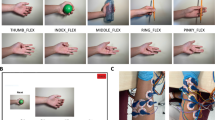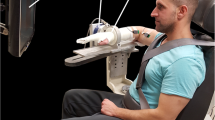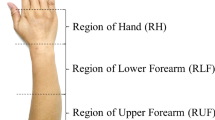Abstract
In robotic rehabilitation, the classification of motion intents and detection of fatigue from surface electromyography (sEMG) are important to guarantee safety during the rehabilitation process. The time-varying characteristics of sEMG can induce errors in related applications such as force/torque estimation, detection of muscle fatigue, and pattern recognition. We investigated the effects of long-term wrist contractions on the classification accuracy of stroke patients in fatigue. Seven stroke patients participated to repeatedly perform sessions of four isometric wrist movements, namely, flexion, extension, radial deviation, and ulnar deviation in different sessions until exhaustion over 4 days. Each movement was successively performed by 60 s with 30 s of rest. To avoid excessive muscle fatigue, subjects were asked to perform each movement at 20% of the maximum voluntary contraction. We classified the four types of wrist movements using an artificial neural network and investigated variations of sEMG features in fatigue. The results showed that not only the classification accuracy but also the manifestation of muscle fatigue from sEMG remained consistent during long-term contractions in fatigue. The average classification accuracy for all patients was 0.91 ± 0.07 without significant difference between sessions.










Similar content being viewed by others
References
Go, A. S., et al. (2013). Executive summary: Heart disease and stroke statistics-2013 update: A report from the American Heart Association. Circulation, 127(1), 143–152.
Broeks, J. G., Lankhorst, G. J., Rumping, K., & Prevo, A. J. H. (1999). The long-term outcome of arm function after stroke: Results of a follow-up study. Disability and Rehabilitation, 21(8), 357–364.
Montagnani, F., Controzzi, M., & Cipriani, C. (2015). Is it finger or wrist dexterity that is missing in current hand prostheses? IEEE Transactions on Neural Systems and Rehabilitation Engineering, 23(4), 600–609.
Lambercy, O., et al. (2011). Effects of a robot-assisted training of grasp and pronation/supination in chronic stroke: A pilot study. Journal of Neuroengineering and Rehabilitation, 8(1), 63.
Kim, S., et al. (2019). Development of an armband emg module and a pattern recognition algorithm for the 5-finger myoelectric hand prosthesis. International Journal of Precision Engineering and Manufacturing, 20, 1–10.
Cesqui, B., Tropea, P., Micera, S., & Krebs, H. I. (2013). EMG-based pattern recognition approach in post stroke robot-aided rehabilitation: A feasibility study. Journal of Neuroengineering and Rehabilitation, 10(1), 75.
Kim, H., Lee, J., & Kim, J. (2020). Muscle synergy analysis for stroke during two degrees of freedom reaching task on horizontal plane. International Journal of Precision Engineering and Manufacturing, 21, 319–328.
No, Y., Hong, G., Lee, J., Kim, P., & Shin, C. S. (2020). Gender differences in the activation and co-activation of lower extremity muscles during the stair to ground descent transition. International Journal of Precision Engineering and Manufacturing. https://doi.org/10.1007/s12541-020-00348-2.
Thielbar, K. O., et al. (2017). Benefits of using a voice and EMG-driven actuated glove to support occupational therapy for stroke survivors. IEEE Transactions on Neural Systems and Rehabilitation Engineering, 25(3), 297–306.
Hu, X. L., Tong, R. K. Y., Ho, N. S. K., Xue, J. J., Rong, W., & Li, L. S. W. (2015). Wrist rehabilitation assisted by an electromyography-driven neuromuscular electrical stimulation robot after stroke. Neurorehabilitation and Neural Repair, 29(8), 767–776.
Nam, C., Rong, W., Li, W., Xie, Y., Hu, X., & Zheng, Y. (2017). The effects of upper-limb training assisted with an electromyography-driven neuromuscular electrical stimulation robotic hand on chronic stroke. Frontiers in Neurology, 8, 679.
Rose, C. G., Pezent, E., Kann, C. K., Deshpande, A. D., & O’Malley, M. K. (2018). Assessing wrist movement with robotic devices. IEEE Transactions on Neural Systems and Rehabilitation Engineering, 26(8), 1585–1595.
Sun, R., Song, R., & Tong, K. Y. (2014). Complexity analysis of EMG signals for patients after stroke during robot-aided rehabilitation training using fuzzy approximate entropy. IEEE Transactions on Neural Systems and Rehabilitation Engineering, 22(5), 1013–1019.
Lee, S. W., Wilson, K. M., Lock, B. A., & Kamper, D. G. (2011). Subject-specific myoelectric pattern classification of functional hand movements for stroke survivors. IEEE Transactions on Neural Systems and Rehabilitation Engineering, 19(5), 558–566.
McManus, L., Hu, X., Rymer, W. Z., Suresh, N. L., & Lowery, M. M. (2017). Motor unit activity during fatiguing isometric muscle contraction in hemispheric stroke survivors. Frontiers in Human Neuroscience, 11(November), 1–12.
Hu, X. L., Tong, K. Y., & Hung, L. K. (2006). Firing properties of motor units during fatigue in subjects after stroke. Journal of Electromyography and Kinesiology, 16(5), 469–476.
Li, X., Shin, H., Zhou, P., Niu, X., Liu, J., & Rymer, W. Z. (2014). Power spectral analysis of surface electromyography (EMG) at matched contraction levels of the first dorsal interosseous muscle in stroke survivors. Clinical Neurophysiology, 125(5), 988–994.
Zhang, X., Wei, Z., Ren, X., Gao, X., Chen, X., & Zhou, P. (2017). Complex neuromuscular changes post-stroke revealed by clustering index analysis of surface electromyogram. IEEE Transactions on Neural Systems and Rehabilitation Engineering, 25(11), 2105–2112.
Lambelet, C., Lyu, M., Woolley, D., Gassert, R., & Wenderoth, N. (2017). The eWrist—a wearable wrist exoskeleton with sEMG-based force control for stroke rehabilitation. In IEEE int. conf. rehabil. robot. (pp. 726–733).
Pizzolato, S., Tagliapietra, L., Cognolato, M., Reggiani, M., Müller, H., & Atzori, M. (2017). Comparison of six electromyography acquisition setups on hand movement classification tasks. PLoS ONE, 12(10), 1–17.
Na, Y., & Kim, J. (2017). Dynamic elbow flexion force estimation through a muscle twitch model and sEMG in a fatigue condition. IEEE Transactions on Neural Systems and Rehabilitation Engineering, 25(9), 1431–1439.
Luttmann, A., Jäger, M., & Laurig, W. (2000). Electromyographical indication of muscular fatigue in occupational field studies. International Journal of Industrial Ergonomics, 25(6), 645–660.
Hostens, I., & Ramon, H. (2005). Assessment of muscle fatigue in low level monotonous task performance during car driving. Journal of Electromyography and Kinesiology, 15(3), 266–274.
Charles, S. K., & Hogan, N. (2011). Dynamics of wrist rotations. Journal of Biomechanics, 44(4), 614–621.
Micera, S., Carpaneto, J., & Raspopovic, S. (2010). Control of hand prostheses using peripheral information. IEEE Reviews in Biomedical Engineering, 3, 48–68.
Al-Mulla, M. R., Sepulveda, F., & Colley, M. (2011). A review of non-invasive techniques to detect and predict localised muscle fatigue. Sensors, 11(4), 3545–3594.
Ates, S., Haarman, C. J. W., & Stienen, A. H. A. (2017). SCRIPT passive orthosis: Design of interactive hand and wrist exoskeleton for rehabilitation at home after stroke. Autonomous Robots, 41(3), 711–723.
Saadatzi, M., Long, D. C., & Celik, O. (2019). Comparison of human-robot interaction torque estimation methods in a wrist rehabilitation exoskeleton. Journal of Intelligent Robotic Systems, 94(3–4), 565–581.
Enoka, R. M. (2012). Muscle fatigue–from motor units to clinical symptoms. Journal of Biomechanics, 45(3), 427–433.
Peternel, L., Fang, C., Tsagarakis, N., & Ajoudani, A. (2019). A selective muscle fatigue management approach to ergonomic human-robot co-manipulation. Robotics and Computer-Integrated Manufacturing, 58, 69–79.
De Luca, C. J., Gilmore, L. D., Kuznetsov, M., & Roy, S. H. (2010). Filtering the surface EMG signal: Movement artifact and baseline noise contamination. Journal of Biomechanics, 43(8), 1573–1579.
Soo, Y., et al. (2010). Estimation of handgrip force using frequency-band technique during fatiguing muscle contraction. Journal of Electromyography and Kinesiology, 20(5), 888–895.
Zhang, X., Li, Y., Chen, X., Li, G., Rymer, W. Z., & Zhou, P. (2013). The effect of involuntary motor activity on myoelectric pattern recognition: A case study with chronic stroke patients. Journal of Neural Engineering, 10(4), 046015.
Artemiadis, P. K., & Kyriakopoulos, K. J. (2010). An EMG-based robot control scheme robust to time-varying EMG signal features. IEEE Transactions on Information Technology in Biomedicine, 14(3), 582–588.
Artemiadis, P. K., & Kyriakopoulos, K. J. (2010). A switching regime model for the EMG-based control of a robot arm. IEEE Transactions on Systems, Man, and Cybernetics, Part B (Cybernetics), 41(1), 53–63.
Bunderson, N. E., & Kuiken, T. A. (2012). Quantification of feature space changes with experience during electromyogram pattern recognition control. IEEE Transactions on Neural Systems and Rehabilitation Engineering, 20(3), 239–246.
He, J., Zhang, D., Jiang, N., Sheng, X., Farina, D., & Zhu, X. (2015). User adaptation in long-term, open-loop myoelectric training: implications for EMG pattern recognition in prosthesis control. Journal of neural engineering, 12(4), 046005.
Acknowledgements
This work was supported by the Research Program of NRCRI [18-A-03].
Author information
Authors and Affiliations
Corresponding author
Additional information
Publisher's Note
Springer Nature remains neutral with regard to jurisdictional claims in published maps and institutional affiliations.
Rights and permissions
About this article
Cite this article
Na, Y., Lee, H. & Kwon, S. Investigating the Effects of Long-Term Contractions on Myoelectric Recognition of Wrist Movements from Stroke Patients. Int. J. Precis. Eng. Manuf. 21, 1771–1779 (2020). https://doi.org/10.1007/s12541-020-00364-2
Received:
Revised:
Accepted:
Published:
Issue Date:
DOI: https://doi.org/10.1007/s12541-020-00364-2




